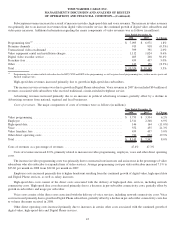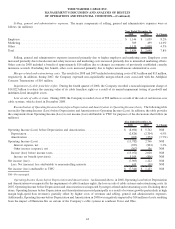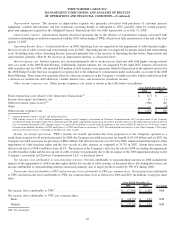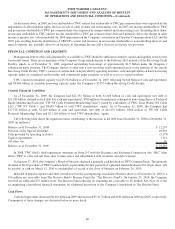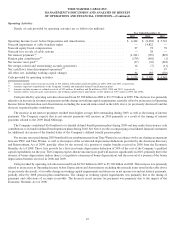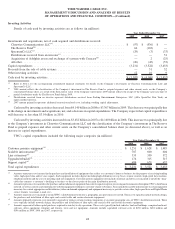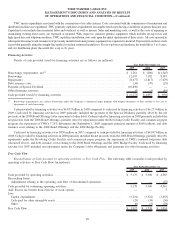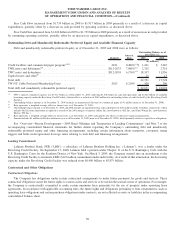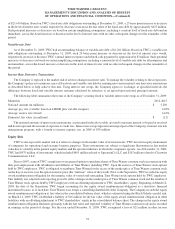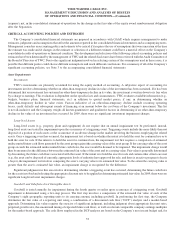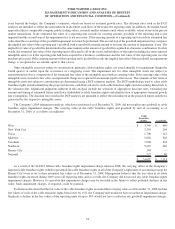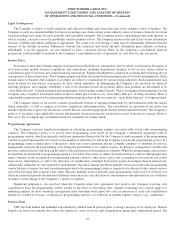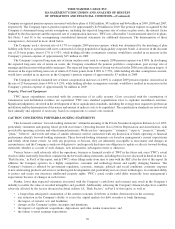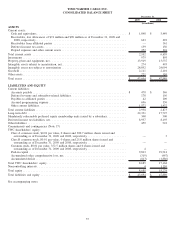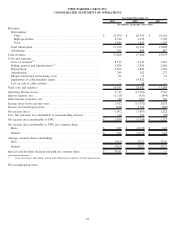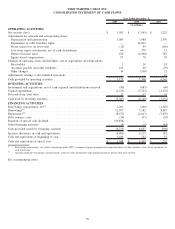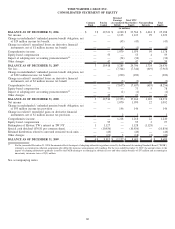Time Warner Cable 2009 Annual Report Download - page 65
Download and view the complete annual report
Please find page 65 of the 2009 Time Warner Cable annual report below. You can navigate through the pages in the report by either clicking on the pages listed below, or by using the keyword search tool below to find specific information within the annual report.(expense), net, in the consolidated statement of operations for the change in the fair value of the equity award reimbursement obligation
after the Separation.
CRITICAL ACCOUNTING POLICIES AND ESTIMATES
The Company’s consolidated financial statements are prepared in accordance with GAAP, which requires management to make
estimates, judgments and assumptions that affect the amounts reported in the consolidated financial statements and accompanying notes.
Management considers an accounting policy and estimate to be critical if it requires the use of assumptions that were uncertain at the time
the estimate was made and if changes in the estimate or selection of a different estimate could have a material effect on the Company’s
consolidated results of operations or financial condition. The development and selection of the following critical accounting policies and
estimates have been determined by the management of TWC and the related disclosures have been reviewed with the Audit Committee of
the Board of Directors of TWC. Due to the significant judgment involved in selecting certain of the assumptions used in these areas, it is
possible that different parties could choose different assumptions and reach different conclusions. For a summary of all of the Company’s
significant accounting policies, see Note 3 to the accompanying consolidated financial statements.
Asset Impairments
Investments
TWC’s investments are primarily accounted for using the equity method of accounting. A subjective aspect of accounting for
investments involves determining whether an other-than-temporary decline in value of the investment has been sustained. If it has been
determined that an investment has sustained an other-than-temporary decline in its value, the investment is written down to its fair value
by a charge to earnings. This evaluation is dependent on the specific facts and circumstances. TWC evaluates available information (e.g.,
budgets, business plans, financial statements, etc.) in addition to quoted market prices, if any, in determining whether an
other-than-temporary decline in value exists. Factors indicative of an other-than-temporary decline include recurring operating
losses, credit defaults and subsequent rounds of financing at an amount below the cost basis of the Company’s investment. This list
is not all-inclusive and the Company weighs all known quantitative and qualitative factors in determining if an other-than-temporary
decline in the value of an investment has occurred. In 2009, there were no significant investment impairment charges.
Long-lived Assets
Long-lived assets (e.g., property, plant and equipment) do not require that an annual impairment test be performed; instead,
long-lived assets are tested for impairment upon the occurrence of a triggering event. Triggering events include the more likely than not
disposal of a portion of such assets or the occurrence of an adverse change in the market involving the business employing the related
assets. Once a triggering event has occurred, the impairment test is based on whether the intent is to hold the asset for continued use or to
hold the asset for sale. If the intent is to hold the asset for continued use, the impairment test first requires a comparison of estimated
undiscounted future cash flows generated by the asset group against the carrying value of the asset group. If the carrying value of the asset
group exceeds the estimated undiscounted future cash flows, the asset would be deemed to be impaired. The impairment charge would
then be measured as the difference between the estimated fair value of the asset and its carrying value. Fair value is generally determined
by discounting the future cash flows associated with that asset. If the intent is to hold the asset for sale and certain other criteria are met
(e.g., the asset can be disposed of currently, appropriate levels of authority have approved the sale, and there is an active program to locate
a buyer), the impairment test involves comparing the asset’s carrying value to its estimated fair value. To the extent the carrying value is
greater than the asset’s estimated fair value, an impairment charge is recognized for the difference.
Significant judgments in this area involve determining whether a triggering event has occurred, determining the future cash flows
for the assets involved and selecting the appropriate discount rate to be applied in determining estimated fair value. In 2009, there were no
significant long-lived asset impairment charges.
Goodwill and Indefinite-lived Intangible Assets
Goodwill is tested annually for impairment during the fourth quarter or earlier upon occurrence of a triggering event. Goodwill
impairment is determined using a two-step process. The first step involves a comparison of the estimated fair value of each of the
Company’s eight geographic reporting units to its carrying amount, including goodwill. In performing the first step, the Company
determines the fair value of a reporting unit using a combination of a discounted cash flow (“DCF”) analysis and a market-based
approach. Determining fair value requires the exercise of significant judgment, including judgment about appropriate discount rates,
perpetual growth rates, the amount and timing of expected future cash flows, as well as relevant comparable company earnings multiples
for the market-based approach. The cash flows employed in the DCF analyses are based on the Company’s most recent budget and, for
53
TIME WARNER CABLE INC.
MANAGEMENT’S DISCUSSION AND ANALYSIS OF RESULTS
OF OPERATIONS AND FINANCIAL CONDITION—(Continued)


